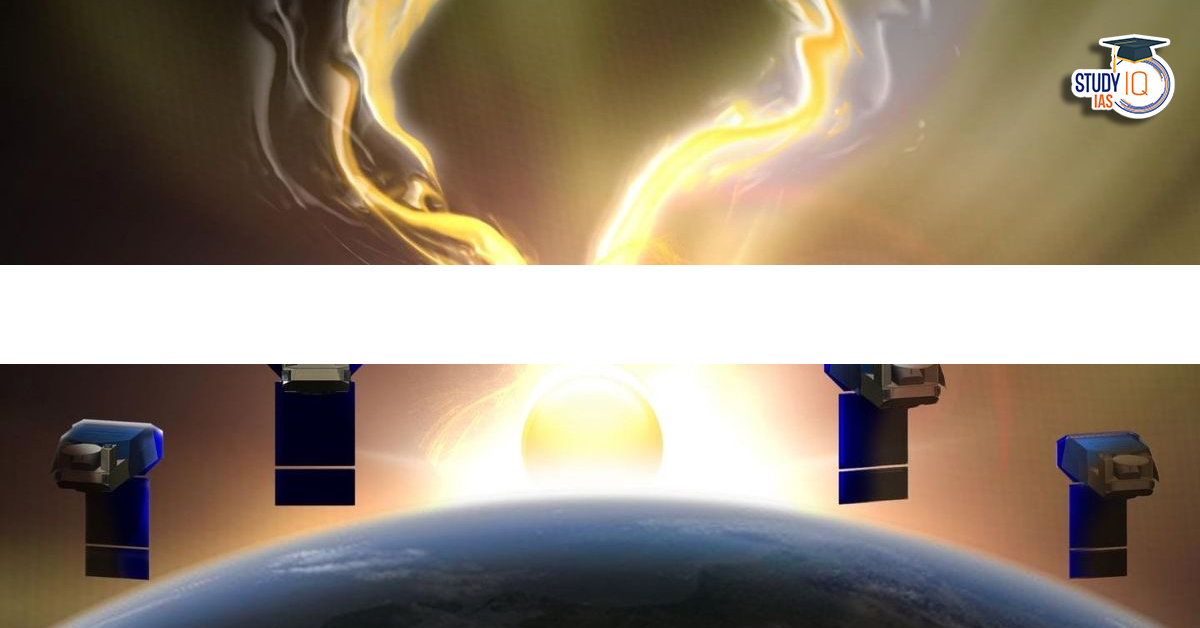Table of Contents
The PUNCH (Polarimeter to Unify the Corona and Heliosphere) Space Mission is an upcoming NASA heliophysics mission, scheduled for launch in March 2025. Recently, the Principal Investigator of the mission shared key insights at the Indian Institute of Space Science and Technology (IIST), Thiruvananthapuram — highlighting India’s growing engagement in global space science discussions.
About the PUNCH Mission
-
Full Form: Polarimeter to Unify the Corona and Heliosphere
-
Launched By: NASA (National Aeronautics and Space Administration)
-
Launch Date: Expected in March 2025
-
Mission Type: Heliophysics Mission (focused on studying the Sun and solar wind)
-
Objective: To study the Sun’s outer atmosphere (corona) and how it connects to the heliosphere, the vast region dominated by the Sun’s solar wind.
Mission Composition
The PUNCH mission consists of four small satellites flying in formation around Earth. Together, they will provide continuous, panoramic, and 3D imaging of the transition zone from the Sun’s corona to the heliosphere.
1. Narrow Field Imager (NFI):
-
Designed to focus on the inner corona, the region closest to the Sun’s surface.
-
Helps capture detailed imagery of solar eruptions and structures.
2. Three Wide Field Imagers (WFIs):
-
Observe the outer solar corona and solar wind as it flows out into space.
-
Provide wide-angle views to track solar material across large distances.
Unique Feature – Polarimetry
At the core of PUNCH’s science lies polarimetry, a technique that measures polarized sunlight — similar to how polarized sunglasses reduce glare.
By analyzing this polarized light, PUNCH can infer the 3D structure and density of the solar corona and solar wind, giving scientists an unprecedented look at how solar material moves and evolves in space.
Scientific Goals of the PUNCH Mission
-
Bridge the Gap: To connect observations of the solar corona with the heliosphere, providing a complete view of solar wind origins.
-
Understand Solar Wind Formation: Determine how the solar wind is formed and how it carries energy and magnetic fields through space.
-
Improve Space Weather Forecasting: Enhance predictions of solar storms that can impact Earth’s satellites, communication networks, and power grids.
-
Support Future Missions: Provide valuable data for upcoming missions such as Parker Solar Probe and Solar Orbiter.
Significance of the Mission
-
The Sun’s corona and heliosphere influence the entire solar system, affecting everything from planetary atmospheres to space missions.
-
By unifying observations of both, PUNCH will help scientists better understand how solar activity shapes space weather and impacts Earth’s magnetosphere.
-
The mission represents an important step in NASA’s Heliophysics Division, aimed at understanding the dynamic space environment humans live in.
Recent Developments and India’s Role
The Principal Investigator of PUNCH recently presented detailed insights at IIST, Thiruvananthapuram, fostering scientific collaboration and knowledge sharing with Indian space scientists.
This interaction highlights India’s rising status in solar physics research, especially after the success of ISRO’s Aditya-L1 Mission, which also studies the Sun.
Conclusion
The PUNCH Space Mission is set to revolutionize our understanding of how the Sun’s corona connects to the heliosphere.
By using advanced polarimetric imaging and a multi-satellite constellation, it will provide a comprehensive 3D picture of the solar wind’s origin and evolution.
As the world prepares for its launch in March 2025, the PUNCH mission stands as a crucial step toward decoding the Sun’s mysteries and protecting Earth from solar storms.


 World Summit on Disaster Management (WSD...
World Summit on Disaster Management (WSD...
 Domestic Systemically Important Banks (D...
Domestic Systemically Important Banks (D...
 The Missing Link in India’s Critical M...
The Missing Link in India’s Critical M...

























